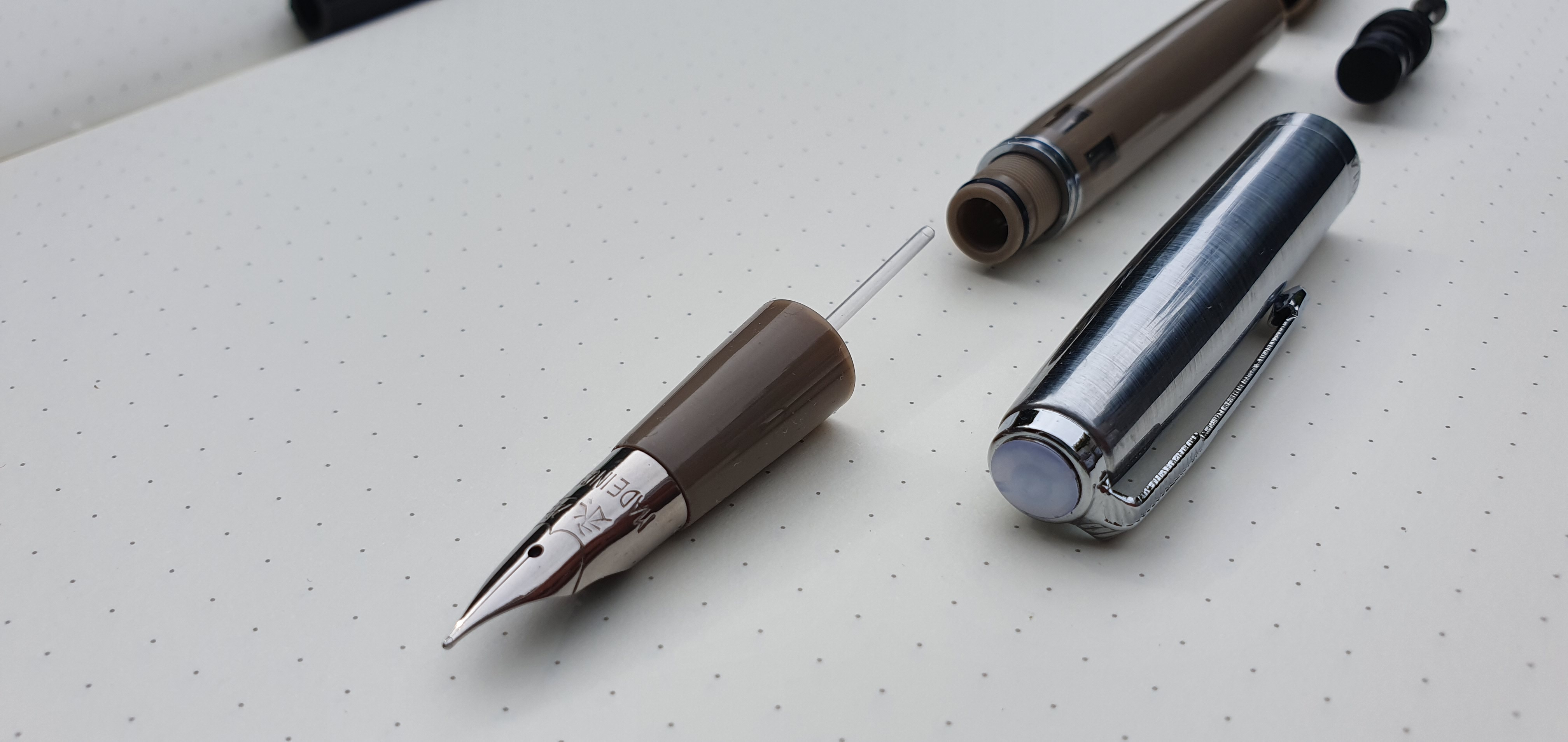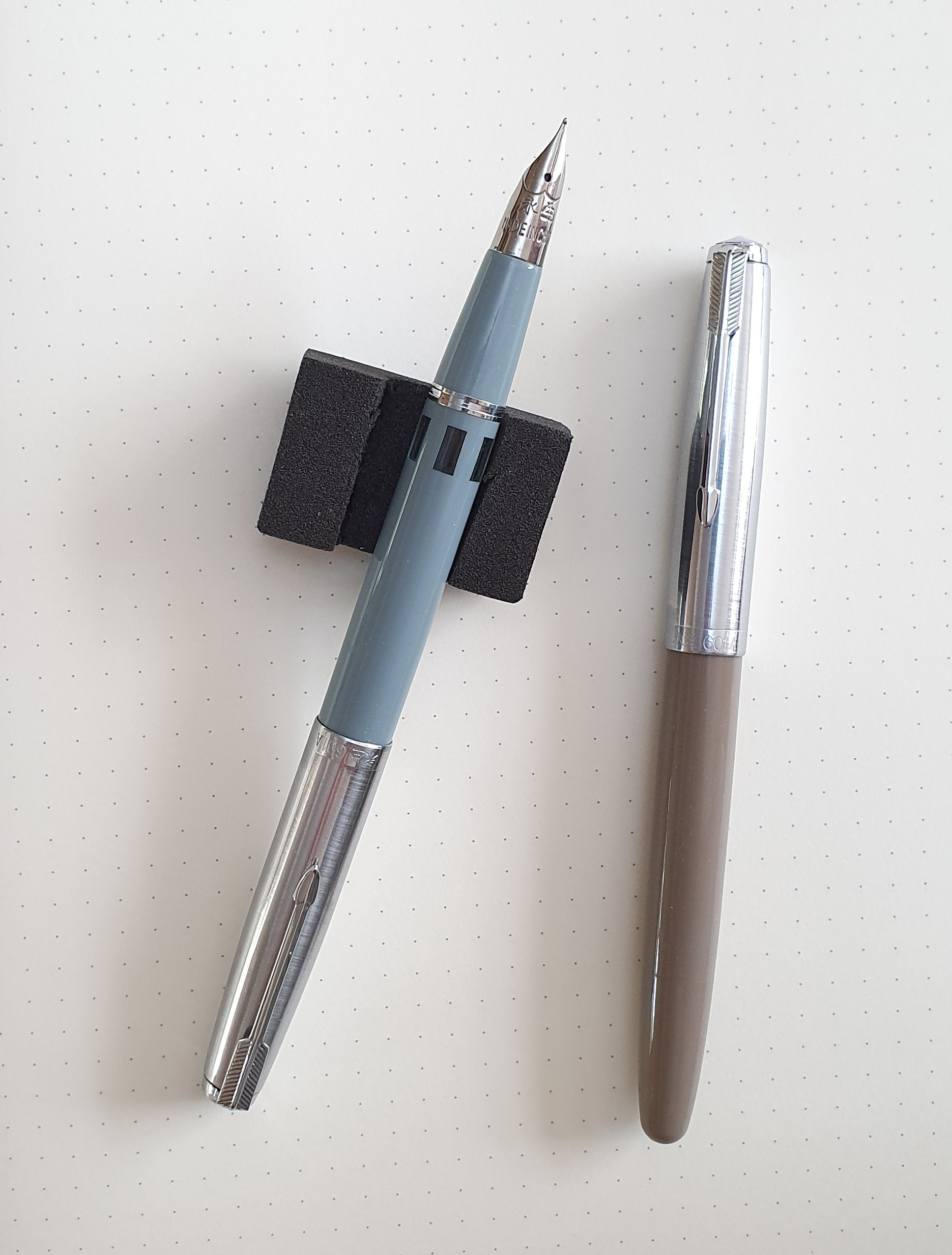It has been over a year since I bought my first Wing Sung 601, a clear demonstrator, in June 2018. I swiftly bought another in Lake Blue. They have both been inked ever since. My review of this inexpensive Chinese pen can be found here: Another look at the Wing Sung 601 fountain pen.
In December 2018 I added a pair of Wing Sung 601A pens, which looked similar on the outside, but had a totally different, large tubular nib unit, rather like a Sheaffer Triumph and with a large, cut ebonite feed. Again, these arrived in simple cardboard packaging and with a container of silicone grease. However there was one more welcome extra – a tubular plastic hexagonal wrench for the filling mechanism. This also fits the 601, making it very simple to remove and re-grease the plunger or diaphragm unit, on either version.
Credit is due to the informative Youtube reviews of these pens, in Pen Talk by Chrisrap52. I learned that there are different types of filling mechanism, although both are operated in the same way by unscrewing a blind cap and pressing on a sprung metal rod a few times, whilst holding the pen with the nib immersed in ink. I gather that the older versions of the 601 (first generation) have a soft rubber bladder inside. These can be identified by a metal conical finial on the cap. The second generation (which I am looking at today) have a hard rubber plunger inside and are identified by a plastic jewel finial in the cap.
As it was high time my 601A’s had a bath, I took the opportunity to try out the wrench and disassemble the pens for a clean. The nib section unscrews easily enough and there is a black rubber o-ring to help prevent leaks. The threads are quite fine and on reassembling, it helps to begin by turning gently in the wrong direction, to correctly align the threads.

The filling mechanism, accessed by removing the blind cap, is unscrewed with the wrench. One was quite stiff the first time. The unit is then withdrawn from the back of the barrel.

The Chinese instruction sheet supplied with the pen does not discuss removing the filling mechanism, (despite providing a wrench for this purpose) but recommends leaving the nib unit to soak in water for 12 hours if changing ink colour and then flushing it with running water until the water runs clear.
After removing the filling mechanism, I was a little worried that I could not see a spring anywhere and feared that I might have lost it. However there is no need to worry as it is hidden underneath the rubber plug. You can find it by separating the two plugs with your finger nail. Once screwed in place on the barrel, you can press the plunger rod and feel the resistance of the spring. It works very well and serves to fill the pen within a few presses. The first generation (diaphragm) needed more presses, maybe 10, not that this was any hardship.

According to the instructions, you immerse the nib in the ink, press the button and release, fairly quickly, within a second, and repeat about 5 – 6 times. On the last press, you keep the button pressed down while you withdraw the pen from the ink; let go of the button and then eject about 5 – 8 drops. Presumably this clears excess ink from the feed so that the pen does not leak or write too wet straight after filling.
The instructions also recommend keeping the pen filled, to guard against leaks from temperature or pressure changes.
The pen holds a whopping 2ml of ink which, combined with its fine nib, makes for long intervals between fills. The push on cap, makes a good seal and I have had no problems of hard starts or skips, even after months of infrequent use.
This is a very enjoyable pen to use and to tinker with. It is satisfying to be able to disassemble and clean the pen so easily, now with a wrench that is made for the job and to spread a little grease on the threads and plunger. I must admit though, that I still prefer the look of the 601 with its hooded nib to the 601A, even though in use, it is more difficult to see exactly where the nib point is. I also found that mine benefited from a little nib smoothing with micromesh, to turn it into a super smooth, wet fine. It is hard to beat one of these pens, for value for money.


I’m always fascinated about how other people do this sort of thing. Great post! Thank you.
I’m interested–being a bit picky about stains in converters and so on, I get a little paranoid about regular cleaning. Recently, I started using white vinegar to flush nibs and converters, followed by extensive flushing with clean water. It cleans very, very well. To date, it hasn’t hurt any of the plastic sections or feeds, but I wonder about long-term use. I can’t seem to find anything that really gives much information on the relative merits… the acid pH of the vinegar always leaves me a little worried when I use it. Any thoughts/experience?
LikeLike
Thank you Paul. I have not tried using white vinegar to clean pens and so have no words of wisdom on this. I have used only tap water, or perhaps rarely some detergent such as Fairy Liquid. I know Laura recommends using Waterman Serenity Blue in a pen to clean it, a tip I picked up from her blog. I do not have an ultrasonic cleaner. I heard recently that hard water can lead to blocked feeds which is a worry now as London is a hard water area. A good reason to not have too many pens inked and standing idle for too long perhaps (which I am guilty of…currently 23 inked). Refilling a pen regularly from a bottle helps keep the feed channels open.
LikeLiked by 1 person
Thanks! This is a thorny area, and needs more research I think. An ultrasonic cleaner has long been on my virtual shopping list… I might have to look at that more seriously–can’t help but think that the vinegar is risky, or we’d be reading about more people using the stuff 🙂
LikeLiked by 1 person
Speaking as a university chemist, I don’t think an occasional SHORT bath in diluted vinegar, followed by a very thorough rinsing should do any harm. Vinegar is a mild (non-aggressive) acid, as acids go; if any hard water deposits are being left behind, it will surely dissolve them. Nonetheless, to be safe, dilute the vinegar with distilled, deionized or soft water, and don’t use it too frequently. Acids will attack metals.
A few drops of washing up liquid (Dawn is preferred here in the States) in several ounces of soft or distilled water is normally all that is required to clean fountain pens. A 1:10 dilution of mild household ammonia solution in the same water is usually recommended for hard-to-remove ink deposits. If such ammonia is not available locally at the grocer’s, hardware, or chemist’s shop, it might be more practical obtain one of the several proprietary cleaners designed for fountain pens. Most of them merely employ safe detergents plus a little ammonia, anyway.
In any case, always be certain to flush and re-flush your pen completely clear of ALL cleaning agents, even the mildest, using soft or distilled water, after any cleaning. Then drain until dry. Remember, most cleanings require the repeated use of only cool,clean water. I am of the habit of rinsing my pen between all refillings, even with the same ink. I am simply much, much more thorough when I change inks.
LikeLiked by 2 people
Thank you for such detailed and helpful comments.
Here in the UK I think distilled water may be more difficult to find than in the States. My pen flushing mostly consists of soaking in tap water and squirting water through the section using a rubber blower. It is good to know that an occasional use of very dilute vinegar or washing up liquid is effective and not harmful.
LikeLiked by 1 person
Thanks for the reply guys!
I must be the only one who has found that water—distilled or otherwise, with or without detergents—just doesn’t cut it, especially for dark inks, such as burgundy or brown. Whereas the ≈15% acetic acid in white vinegar pretty much clears any pen in one or two flushes. Now I’m thinking that, although that may work short-term, frequent use, even with flushing clean water through after the vinegar, may be too much of a risk… the biologist in me wants to run a few long-term soak tests, and add a few neutral pH controls—just not in any of my pens thanks 🙂
Thanks again Brian!
LikeLiked by 1 person
Interesting blog. As a fan of the Parker 51, I’ve long been looking for an alternative Chinese variant that can be used daily. I spend a few weeks in Beijing with work every year, and have a number of Chinese pens from cheap, low end bits up to fancy bits like Duke. About two and a bit years ago I discovered the Wing Sung 601, and it has become a real favourite. I think I now own something like a dozen of them in as many colours as I could find. I’ve laso just ordered my first alumnium bodied model too. After trying Hero 100 (too narrow in the body) and several other alternatives since 2008, this is the perfect replacement. I still enjoy my other pens, but the WS is the go to. I also have a couple of 601As. Nice, though I too prefer the hooded nib of the 601. Recently I did partially dismantle one of my demonstrator models when the nib and feed got displaced. Maintenance on these pens is a joy. I now plan to buy a few spare plunger mechanisms just in case I need them for future repairs. I wodner has anyone ever compared theem, size-wis,e to orignial 51s to see if they would be a fit?
I’ve only ever tended to flush my pens whenever I’ve not used a pen for a long time; as a rule, I quite enjoy the slow transition of one colour into another as I write (I even mixed my own ink once in order to replicate a shade I discovered that way).
LikeLiked by 1 person
Thank you for visiting the blog and for your interesting comments. It is good to know that you are finding the Wing Sung 601 a good “go to” Chinese alternative to the Parker 51. I wrote again about the disassembly of the 601 in a recent blog post, “Going inside the Wing Sung 601 fountain pen” (in case you missed it), although you are clearly familiar with the process!
I am also much enjoying the Wing Sung 699, which is a larger pen and is another “homage”, this time to the Pilot Custom 823.
LikeLike